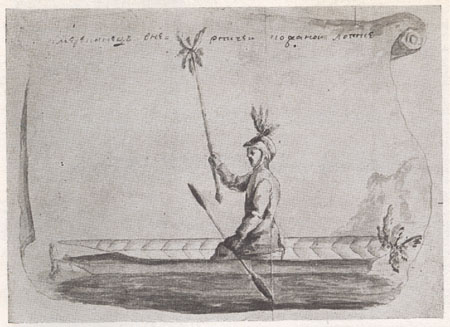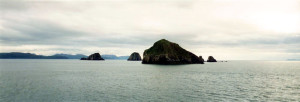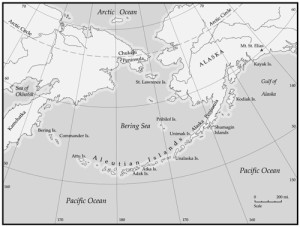First Meetings in the North Pacific: Russians and “Americans” in the Aleutians

First meetings on the Atlantic are well known. There is Columbus and his meeting with the Arawaks. There is Cortés’s meeting with natives on the east coast of Mexico. There is also John White, Thomas Harriott, and the English meeting with the Eastern Algonquians in what became the Lost Colony of Roanoke in 1584. There was also the meeting of Captain John Smith with the Powhatan Confederacy and Pocahontas on the coast of Virginia in 1607.
This is another first meeting: this time on the North Pacific in the Aleutian Islands. Today this area is part of the state of Alaska. In the mid-eighteenth century when this meeting takes place, it was on one of the more than seven hundred islands on the Aleutian archipelago spanning a distance of thirteen hundred miles. Its residents were the Unangan people, called by their “discoverers” first “Americans” and then Aleuts.
In 1728 Russia’s Peter the Great sent Vitus Bering to explore the existence of a “Great Land” beyond northern Asia and the Kamchatka peninsula. During Bering’s second voyage on September 5, 1741, at about 4:00 P.M. off one of the Shumagin Islands, “Americans” appeared and a first contact between the Russian expedition and these people occurred. This meeting signals the ambiguities and difficulties that would be part of Russian-native relations in Alaska for more than 120 years.
One major reason propelled the first large numbers of Russians across the vast reaches of Siberia: furs. Those fur traders were called promyshlenniki. The traditions of these men go back to the sixteenth century. By the reign of Ivan the Terrible (1533-84), they were given the freedom to hunt the Russian forests. They formed their own groups, chose leaders, and shared profits among themselves and their financiers. Their determination for sable destroyed the fur bearing animals around Moscow. By 1560 the price of sable went so high that, according to one writer, “a single pelt could buy a fifty-acre farm.”
Thus did America’s North Pacific call. It was thousands of miles away. Even in Siberia furs were contested property. Cossacks defeated Bukharians and opened up the area to hunters of sable, bear, and ermine. They also extracted tribute in furs from the natives called yasak. A fur rush proceeded. By the late sixteenth century a line of forts connected western Russia to the fur centers of the far eastern frontier. A feudal system became a permanent feature with tribute demanded and portions of the traders’ profits sent to St. Petersburg. The Siberian Cossack army served as enforcers, but the fur traders themselves attracted a criminal element and soon gained control of much of the system. By 1639 a Russian fort went up on the Pacific near the Sea of Okhotsk, a distance of about 5900 miles across Siberia from St. Petersburg. But the path to cheap furs was not won easily. Mongols and Chinese were serious contestants. In the process of this growing trade, Irkutsk became the center of trade between Russia and China—a key point en route to the fur frontier and then to the Kamchatka peninsula, across the North Pacific from the still unknown Aleutian Islands.
Vitus Bering became the first major explorer of the North Pacific and the Arctic regions. The Dane’s voyages put the Aleutian lands and peoples permanently on the Russian map. After Peter the Great proposed Bering’s journey, the first attempt succeeded in bringing his men thousands of miles across Russia and Asia to Kamchatka and then into the Aleutians. He and his men brought the first Aleutian seals and sea otters to the attention of Russia, forever changing the fate of those animals and that once remote archipelago.
On his first trip, Bering recognized that by going north and east across from Asia he could find an “Unnamed Land.” In August 1728, while aboard the St. Gabriel in that area we now call the Bering Strait, he tried to negotiate his way to the northwestern tip of the American continent, finally returning to St. Petersburg without success. Whereas it took five years to plan and execute the first expedition to Kamchatka, the second was the work of ten. A mammoth effort with nine hundred men headed out in 1738 with Bering as captain of the St. Peter (or Sv Pert) and the St. Paul (Sv Pavel) under Aleksei Chirikov’s command. Both men made landfall in July, but shortly thereafter lost two boats and fifteen men. Without fresh water or the ability to find out the causes of their misfortune, Chirikov began his return to Kamchatka. Bering too turned back. But tragedy struck. In November Bering’s ship was wrecked off of what is today called Bering Island. That winter both he and half of his men died of scurvy. The following August the others rebuilt a craft and returned to Petropavlovsk in the south of Kamchatka.
The mission of the expedition begun for imperial adventure, expansion, and wealth for Russia in the North Pacific was both an ambitious and an ambiguous one. Although their missions met with disaster, Bering and Chirikov managed to achieve many of their ultimate goals: they mapped territory and proved the existence of the northern reaches of the Americas. The land they saw was now in Russia’s column, and with it a rich source of furs.
What do we know of those first encounters between the Bering expeditions and the men and women of the Aleutians they called “the Americans”? The major scientist on the Bering voyage was the German naturalist, Georg Wilhelm Steller. He documented the principal animals of the Aleutian chain, leaving us the first descriptions of the mammals of the North Pacific: “the sea otter, the fur seal, the sea lion,” and what he called “the hitherto unknown North Pacific sea cow.”
In Steller’s journal we find the most complete discussion of the first meeting between Bering’s men and Unangan or Aleutian peoples. Becalmed late in the afternoon of September 4, 1741, off what is today called Bird Island in the Shumagin Islands, the St. Peter dropped anchor. “Here,” says Steller, “unexpectedly and without searching, we got to see Americans.”
After hearing “a loud noise” they thought was “the roaring of a sea lion” the voyagers soon saw “two small boats being paddled from the shore to our ship.” There the men waited “with the greatest eagerness and utter amazement to mark most carefully the boats’ mountings, shape, and design.” The Americans, now a third of a mile away, stopped, and “two men in the boats, while paddling steadily, began to deliver a long, uninterrupted oration to us in a high-pitched voice, not a word of which any of our interpreters could understand.” It was presumed the men were praying or conjuring and that these were the incantations “of shamans or a ceremony welcoming us as friends, since both are customs in use on Kamchatka and in the Kurile Islands.” The men “paddled closer and closer, shouting continually,” and “began to speak to us with pauses between statements.” But it was a hopeless interaction, as “no one could understand their language.”
At this point the Russians and Stellar “beckoned them with our hands to come closer without fear.” The Americans signaled too that they wished the Russians to land, and indicated that they would provide them with food and water. Thinking they were in an area similar to the northern reaches of eastern North America, the Russians used Baron Lahontan’s work on the natives of that area to give them clues, and unsuccessfully tried the Algonquin word for water.
Then one man from the group of “Americans” paddled toward them and continued his welcome with an elaborate ceremony described by Steller: “before he approached us altogether, he stuck his hand into his bosom, took some iron- or lead-colored shiny earth and painted himself with it from the wings of his nose across the cheeks in the shape of two pears, and stuffed his nostrils full of grass; the wings of his nose on both sides were pierced by fine pieces of bone. Then he took a stick of spruce wood lying behind him on top of the skin boat, painted red like a billiard cue and three arshins long. On this he stuck two falcon wings and bound them fast with baleen, showed it to us, and then, laughing, threw it toward our ship into the water.”
Clearly fascinated by the gesture, Steller remained unable to discern “if it was meant as a sacrifice or a sign of friendship.”
In exchange Bering’s group threw the man two Chinese tobacco pipes and some glass Chinese beads that they had secured on a “piece of board.” The American man then came closer. In his hand he carried a falcon tethered to a stick which he “presented” to the Russians’ interpreter, who gave him “a piece of Chinese silk and a mirror” in exchange. But rather than really wishing to give the bird as a gift, Steller believed the American wanted only to show the bird and then have the silk put “between the bird’s claws so that it wouldn’t get wet.” This misunderstanding resulted in some tugging on both sides. The falcon was taken and the Aleut man was forced to give up the stick and the bird “and it remained in our hands.” This frightened the “American” and he “paddled a little to the side,” unwilling “to come so close again.” The Russians threw the silk and mirror after him and the island men headed to shore “signaling us that we should follow so that they might give us food and drink.” All this happened as “their companions on shore” kept “calling” and “shouting in high voices.” Again Steller and the others on board could not “figure out their intention.”
Nonetheless, the Americans called for them to land and to eat and drink. Steller writes that “after a short discussion, the boat was lowered in which I, along with Lieutenant [Sven] Waxell, the Koriak interpreter, and nine sailors and soldiers, decided to go ashore.” They took with them “plenty of firearms and sabers” but “covered them all with sail cloth to cause no suspicion.” They also brought “biscuits, brandy, and other trifles to be able to give them gifts,” including pipes and tobacco. On heading toward the beach they found their “presents lay without great regard strewn here and there on the beach.” They also saw “men as well as women (who because of the sameness of their dress could hardly be distinguished from one another), came full of amazement and friendliness toward us, not failing to beckon us constantly ashore.”

The weather made a landing impossible. Steller calls the beach “very rocky” with “the water increasingly turbulent and the wind and the waves so heavy that only with the greatest of difficulty could we keep the boat from being dashed to pieces.” Steller continues: seeing the impossibility of the whole group landing “we had our interpreter and two others undress and wade through the water to inspect a thing or two.” These few were greeted “very respectfully, as if they were very important people.” Island people “presented” them “with a piece of whale blubber, and talked some with them, although neither group understood the other.” They also “saw some huts in the distance.”
The Americans urged the Russians still on their small boat to come ashore. The Russians tried to explain how that was impossible to do. Thus an American “got into his boat” and came out to them carrying water under his arm. Brandy was offered but “immediately he spat it out . . . acting strangely about it, and did not seem at all amused by this supposed trick.” A pipe with tobacco was then tried but this too did not work and the man “paddled away.”
As the “water rose up more and more along with the wind we called our people to the boat.” The Americans did not want them to leave and especially liked “our Koriak interpreter, whose speech and looks fully resembled theirs.” When the Americans offered more whale blubber and iron-colored paint and it was refused “they tried to hold on to them by force gripping them by the arms and forcefully keeping them away from the boat.” As the Americans tried to pull in their small boat at some point there was “no time to be lost” in trying “sweet talk” so “we immediately fired three loaded muskets over their heads at the cliff. Right away our men ran through the water and luckily made it into the boat.” They headed out as fast as they could, returning “to the packet boat” not finding what they wanted but “encounter[ing] what we had not expected.”
It appears from Steller’s sensitive but uncertain account that the man coming with the falcon was there to welcome the Russians and make their meeting a propitious one. Whereas the first spruce wood decorated with falcon wings tied with baleen was tossed to them with pleasure, the wand on which the Unangan American presented the whole falcon was probably nota gift, but rather a sacred source of power. The Russians used force to grab the wand away even when it was clear that it was not intended as a gift. This disturbed both the American native and his comrades watching from the shore.
This first encounter was a critical one. As in the first meetings in North, Central, and South America, the Aleutians were hardly virgin lands. People inhabited them, people whom the Russians would ultimately force into servitude. These native people would provide the critical link between the fur-bearing sea creatures and Russian power. Men would catch the animals. Women would turn them into clothing and household goods. The sea otter pelts would provide “soft gold” for the China trade and the Russian fur market. Russians tempted them with liquor and tobacco. It was refused, but on the return of other traders in the 1760s, these were accepted and became addictions. Thus these first meetings in the North Pacific changed forever the lifeways of the Aleutian Islands. Bering’s voyage and its first meeting with Unangan men paved the way for new systems of conquest and control among these island people.
Further Reading:
Some of this material was presented in “Russian and Unangan Encounters in the Aleutians: Economics and Gender, 1728-1764” at the Tenth Annual Conference of the Omohundro Institute of Early American History and Culture at Smith College, June 13, 2004. I would like to thank Alan Gallay for his comments there. I would also like to thank Barbara Sweetland Smith, Elizabeth Dennison, Douglas W. Veltre, and Rochelle Goldberg Ruthchild for comments on earlier drafts.
Readings of Georg Wilhelm Steller may be found in Georg Wilhelm Steller, Journal of a Voyage with Bering 1741-1742, ed. by O.W. Frost, trans. by Margritt A. Engel and O. W. Frost (Stanford, Cal. 1988), esp. 99-102. For another account of the same incident see Sven L. Waxel (also spelled Waxell), “Lieutenant Waxel’s Report on the Voyage of St. Peter” in F.A. Golder, Bering’s Voyages: An Account of Efforts of the Russians to Determine the Relation of Asia and America (New York, 1922), I: 270-81. Aleksei Chirikov’s account for September 9, 1741, may be found in Basil Dmytryshyn et al, eds. and trans., Russian Penetration of the North Pacific Ocean 1700-1797: To Siberia and Russian America, Three Centuries of Russian Eastward Expansion, A Documentary Record (Portland, 1988), vol. 2.
For works on the early Northwest and Alaska see Robin Fisher, “The Northwest from the Beginning of Trade with Europeans to the 1880’s,” in part 2 of North America, vol. 1 of The Cambridge History of the Native Peoples of the Americas, ed. by Bruce G. Trigger and Wilcomb E. Washburn (Cambridge, Eng., 1996); and James R. Gibson, Otter Skins, Boston Ships, and China Goods: The Maritime Fur Trade of the Northwest Coast, 1785-1841 (Seattle and Montreal, 1992). On Bering’s death see Raymond Fisher, “Finding America,” in Russian America: The Forgotten Frontier, ed. by Barbara Sweetland Smith and Redmond J. Barnett (Tacoma, Washington, 1990), 17-31. For the earlier writing, see Hurbert Howe Bancroft, History of Alaska, 1730-1885, vol. 33 of The Works of Hurbert Howe Bancroft (San Francisco, 1886). For the best recent history of Alaska, see Stephen Haycox, Alaska: An American Colony (Seattle, 2002). For a recent and more pro-Russian position see Lydia T. Black, Russians in America 1728-1867 (Fairbanks, 2004). An earlier but less scholarly work is Hector Chevigny, Russian America: The Great Alaskan Venture, 1741-1867 (Portland, Ore., 1965). Also see Svetlana G. Fedorova, Ethnic Processes in Russian America, trans. by Antoinette Shalkop, Occasional Paper No. 1 (Anchorage, 1975); and O. W. Frost, Bering: The Russian Discovery of America (New Haven, 2003); and Gerhard Friedrikh Müller, Bering’s Voyages: The Reports from Russia, trans. with commentary by Carol Urness (Fairbanks, 1986). For a discussion of the role of French writers and explorers in North America see Gordon M. Sayre, Les Sauvages Américains: Representations of Native Americans in French and English Colonial Literature (Chapel Hill and London: 1997).
This article originally appeared in issue 5.2 (January, 2005).
June Namias was associate professor of history at the University of Alaska Anchorage from 1992 until 2003. Her publications include White Captives: Gender and Ethnicity on the American Frontier, 1607-1862 (Chapel Hill, 1993); and a new edition of Sarah F. Wakefield’s Six Weeks in the Sioux Tepees: A Narrative of Indian Captivity (Norman, Ok., 1997). She is at work on a book about eighteenth-century contact and the recent history and people of the Aleutians.


